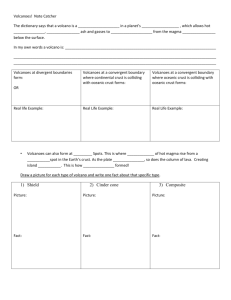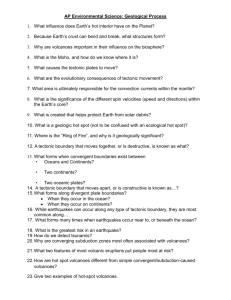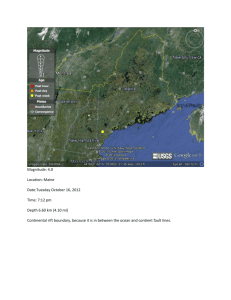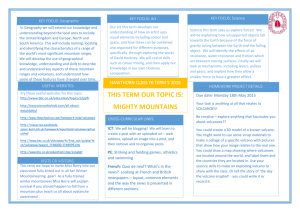Plate Tectonics - Physiographic Chart of the Sea Floor
advertisement
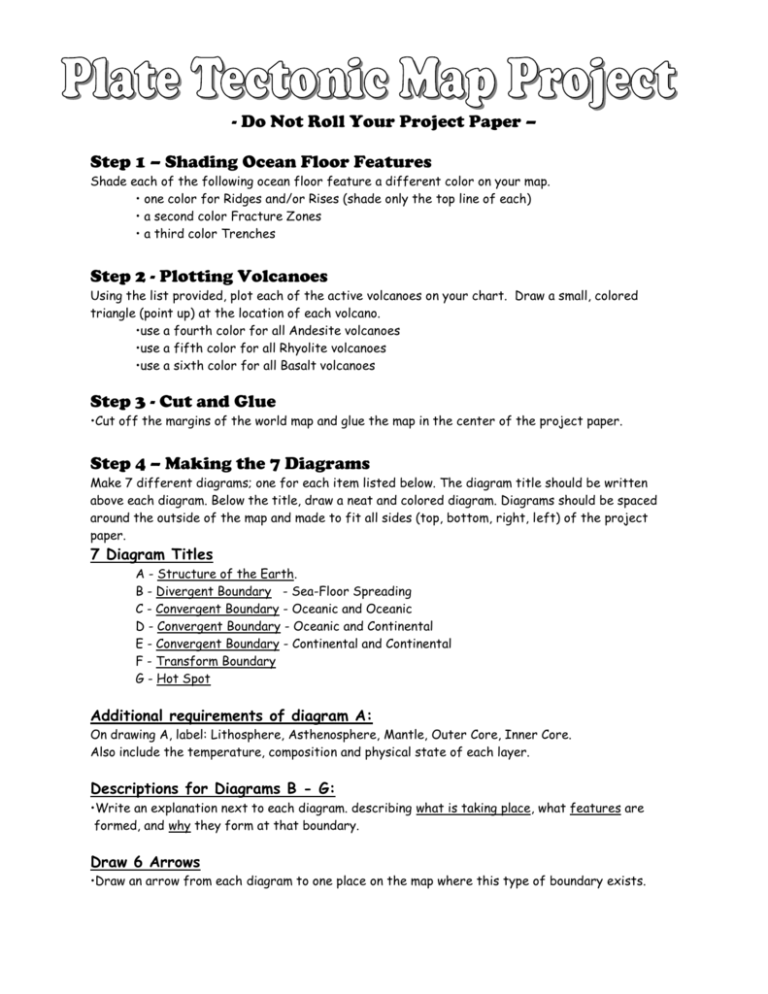
- Do Not Roll Your Project Paper – Step 1 – Shading Ocean Floor Features Shade each of the following ocean floor feature a different color on your map. • one color for Ridges and/or Rises (shade only the top line of each) • a second color Fracture Zones • a third color Trenches Step 2 - Plotting Volcanoes Using the list provided, plot each of the active volcanoes on your chart. Draw a small, colored triangle (point up) at the location of each volcano. •use a fourth color for all Andesite volcanoes •use a fifth color for all Rhyolite volcanoes •use a sixth color for all Basalt volcanoes Step 3 - Cut and Glue •Cut off the margins of the world map and glue the map in the center of the project paper. Step 4 – Making the 7 Diagrams Make 7 different diagrams; one for each item listed below. The diagram title should be written above each diagram. Below the title, draw a neat and colored diagram. Diagrams should be spaced around the outside of the map and made to fit all sides (top, bottom, right, left) of the project paper. 7 Diagram Titles A - Structure of the Earth. B - Divergent Boundary - Sea-Floor Spreading C - Convergent Boundary - Oceanic and Oceanic D - Convergent Boundary - Oceanic and Continental E - Convergent Boundary - Continental and Continental F - Transform Boundary G - Hot Spot Additional requirements of diagram A: On drawing A, label: Lithosphere, Asthenosphere, Mantle, Outer Core, Inner Core. Also include the temperature, composition and physical state of each layer. Descriptions for Diagrams B - G: •Write an explanation next to each diagram. describing what is taking place, what features are formed, and why they form at that boundary. Draw 6 Arrows •Draw an arrow from each diagram to one place on the map where this type of boundary exists. On the Back of the Project Paper Step 5 – Write out the questions and answer each. Earthquake questions 1. How many E.Q.’s did you plot on your world map? 2. How many E.Q.’s are on a Ridge or Rise? 3. How many E.Q.’s are on a Fracture Zone or Transform Boundary? 4. How many E.Q.’s are on a Trench? 5. What percent of the E.Q.’s are on one of the three features listed above? Volcano questions 1. How many volcanoes did you plot on your world map? 2. How many volcanoes are on a Ridge or Rise? 3. How many volcanoes are on a Fracture Zone? 4. How many volcanoes are on a Trench? 5. What percent of the volcanoes are on one of the three features listed above? Step 6 - Essay #1 – Must be hand written Write a short essay that explains the relationship between Earthquakes and Plate Tectonics. What causes E.Q’s? Where do they occur? Why? Is the depth of the E.Q. related to the type of plate boundary? Why? Step 7 - Essay #2 – Must be hand written Write a short essay that explains the relationship between Volcanoes and Plate Tectonics. Is there a relationship between the type of rock formed (Andesite, Rhyolite and Basalt) and the volcanoes location relative to a tectonic feature? Is there a relationship between whether a volcano is explosive or no-explosive and the type of boundary on which it forms? Why? Step 8 Make a Key showing what each color has been used to indicate on your map. FYI Diagrams for the drawings can be from any source you choose including: google images, your text book, or the blue text book in our classroom. Diagram A B C D E F Blue Text Book in Classroom 235 figure 15 259 figure 9D 262 figure 12 261 figure 11 262 figure 13 255 figure 7C G 268 figure 19
